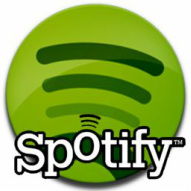
Spotify is a commercial music streaming service providing Digital Rights Management-protected content from record labels including Sony, EMI, Warner Music Group and Universal. Launched in October 2008, Spotify has reached 24 million total users, 6 million of who pay a monthly subscription fee that varies based on locale. The system is currently available using Microsoft Windows, OS X, Linux, iOS, Android, BlackBerry, Windows Mobile, Windows Phone, S60 (Symbian), webOS, Samsung Smart TV, Squeezebox, Boxee, Sonos, WD TV, Roku, MeeGo, Telia Digital-tv, and TiVo.
Music can be browsed by artist, album, record label, genre or playlist as well as by direct searches. On computers, a link allows the listener to purchase selected material via partner retailers. A six-month free trial period is activated upon account registration or first login with a Facebook account, allowing the user to listen to an unlimited amount of music supported by visual and radio-style advertising. After the trial, Spotify has a listening limit of 10 hours per month, divided into 2.5 hour weekly portions (unused hours carry over). The only locations exempt from this rule are the United States, Hong Kong, Singapore, and Malaysia, where ad-supported unlimited streaming continues on Spotify Free after 6 months. An "Unlimited" subscription removes advertisements and time limits and a "Premium" subscription introduces extra features such as higher bitrates streaming, offline access to music and mobile app access. Users can try Spotify Premium for 48 hours by logging into Spotify Mobile for the first time, or get a 30-day trial for their first month.
Revenue Model
Spotify principally operates under a so-called 'Freemium' model: basic services are free and more advanced or additional features are offered at a premium. This is augmented by income from music purchases within the player. As of 2013 Spotify offered a $10 per month unlimited subscription, close to the Open Music Model (OMM) estimated economic equilibrium for the recording industry. Advertisements for non-paying users are 30 seconds ad units. The interval between advertisements is not constant. A monthly fee removes advertisements and streaming limits.
Spotify announced on 6 December 2012 that it had more than five million paying customers globally, including 1 million in the US Spotify also announced that it had over 20 million active users worldwide. By March 2013, Spotify had grown to six million paying customers globally and 24 million total active users.
Spotify isn't a copycat of existing digital music services. It throws in a few new groovy beats of its own, including tools that let you share playlists and songs immediately via social media sites like Facebook and Twitter. In short, Spotify is a lot like having a version of Apple iTunes software wherever you have an Internet connection, giving you access to the tune of roughly 15 million tracks. Spotify advocates say it's kind of like being able to play any song, anywhere -- for free. And that's actually the origin of the Spotify moniker, which helps you "spot" and "identify" songs you like.
Unlike many Internet radio services, which are solely Web-based, you actually have to download and install the Spotify program to your hard drive. Once you've accomplished this minor task, you're ready to plunge into what some people consider the technology that will completely change the way we organize and listen to music.
 RSS Feed
RSS Feed